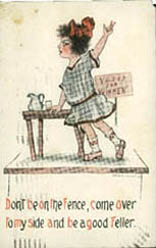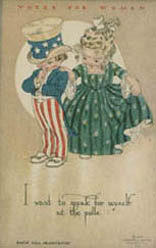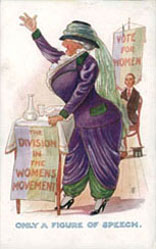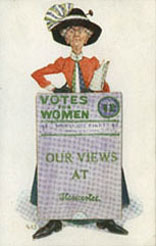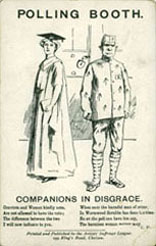Palczewski Suffrage Postcard Archive
This website provides a virtual tour of my archive of suffrage postcards. It is meant to provide a resource for scholars researching the visual images associated with the struggle for woman suffrage in both the United States and Great Britain. These images have been collected by me and my partner, Arnie Madsen, PhD, over the last 15 years. Feel free to use these images for non-commerical purposes, but please remember to provide attribution by indicating where you found these images. Postcard HistoryAlthough we now think of postcards as mass-produced slips of paper (festively decorated with generic images or off-color jokes) to be sent to family and friends from vacation destinations, the social import of postcards during their “Golden Age” (1893-1918) [1] rivals the power of the Internet in contemporary times. The postcard industry was technologically and artistically prepared to play a part in the 1908 presidential election [2], with postcards reaching the height of their popularity during that campaign [3]. Although it would be impossible to quantify their direct effect on the election, postcards “offer a vivid chronicle of American political values and tastes.” [4] Postcards, and their chronicling of American political values, were not confined to electoral politics. Postcard historian Frank W. Staff remarks, “The detail and unusual items of domestic and social history which [postcards] show are of inestimable value to the historian” [5] and, I would add, to those who study the rhetoric of historical movements. In her comprehensive study of British women’s suffrage [6] campaign imagery, Lisa Tickner cites John Fraser’s research on the postcard, suggesting “that the pictorial postcard was ‘possibly the great vehicle for messages of the new urban proletariat between 1900 and 1914’ (it was cheap to buy and to post, simple to use, and quick to arrive in an age of frequent postal deliveries).” [7] In Britain, middle-class collectors formed and joined postcard clubs, subscribed to postcard journals, and attended shows where they would place their collections in competition for medals and awards. [8] During postcards’ heyday in the United States, “no ‘drawing room table’ was complete without one of the special albums in which picture postcards could be preserved” [9] and “one’s social standing could be determined by the style and quality of the picture postcards in the album.” [10] Thus, it is no surprise that postcards both supporting and opposing woman suffrage in the U.S. were common during the movement’s doldrums from 1890-1915 and its developing renaissance from 1896-1910.[11] Accordingly, a fascinating intersection occurred between advocacy for and against woman suffrage, images of women (and men), and postcards. Best estimates are that approximately 4,500 postcards were produced with a suffrage theme. Woman suffrage advocates recognized the utility of the postcard as a propaganda device. In the United States, the majority of the postcards supporting woman suffrage contained real-photo images of the suffrage parades, [12] verbal messages identifying the states that had approved suffrage, or quotations in support of extending the vote to women. [13] However, the most visually evocative images in the United States, as in Great Britain, came not from postcards officially commissioned by woman suffrage groups, but from ones produced by commercial postcard publishers. [14] Simply by tapping into prevailing ideology, postcard producers assisted anti-suffrage forces “almost incidentally” by creating “a public imagery of the female form” that used suffragists as “topical or humorous types.” [15] |
Postcards by topic or artist
Follow links for more postcards
|
|||||||
Notes [1] Susan Brown Nicholson, The Encyclopedia of Antique Postcards (Radnor, PA: Wallaca-Homestead Book Co., 1994), 196. [2] Valerie Monahan, An American Postcard Collector’s Guide (Poole: Blandford Press, 1981), 84. [3] Roger A. Fischer, Tippacanoe and Trinkets Too: The Material Culture of American Presidential Campaigns, 1828-1984 (Urbana: University of Illinois Press, 1988), 148. [4] George Miller, forward to Political Postcards 1900-1980, A Price Guide, by Bernard L. Greenhouse (Syracuse: Postcard Press, 1984). [5] Frank Staff, The Picture Postcard & Its Origins (London, Lutterworth Press, 1966), 8. [6] British suffragists referred to “women’s suffrage” while U.S. suffragists spoke of “woman suffrage.” Accordingly, when referring to British suffrage activities, I use the phrase “women’s suffrage” and when referring to U.S. suffrage activities, I use the phrase “woman suffrage.” [7] Lisa Tickner, The Spectacle of Women: Imagery of the Suffrage Campaign 1907-1914 (Chicago: University of Chicago Press, 1988), 50. [8] Tickner, 50-51. [9] James Laver, foreword to The Picture Postcard & Its Origins (London, Lutterworth Press, 1966), 7. [10] Staff, 64. [11] Eleanor Flexner, Century of Struggle: The Woman’s Rights Movement in the United States (New York: Atheneum, 1973), 248; and Sara Hunter Graham, “The Suffrage Renaissance: A New Image for a New Century, 1896-1910,” in One Woman, One Vote: Rediscovering the Woman Suffrage Movement, ed. Marjorie Spruill Wheeler (Troutdale, OR: NewSage Press, 1995), 159. [12] The visual power of the suffrage parade is best explained in Linda J. Lumsden, “Beauty and the Beasts: Significance of Press Coverage of the 1913 National Suffrage Parade,” Journalism and Mass Communication Quarterly 77, no. 3 (Autumn 2000): 593-611. She argues: “The parade marked a milestone in the incorporation of American women into Society. Part of that incorporation involved the portrayal of women in media” (602). See also Jennifer L. Borda, "The Woman Suffrage Parades of 1910-1913: Possibilities and Limitations of an Early Feminist Rhetorical Strategy," Western Journal of Communication 66, no. 1 (Winter 2002): 25-52. [13] This summary of postcard types comes from the author’s personal collection, a review of postcards available on-line, examination of collections put up for auction, and consultations with suffrage postcard collectors. The differences between pro- and anti-suffrage postcards are not limited to their style and content. Their uses also differed: “Though most cards were heavily anti-suffrage, some were pro-suffrage. When the pro-suffrage cards are found today, they usually have not been postally used. Perhaps the social climate was such that these cards were hand exchanged or merely kept by the purchaser” (Nicholson, 196). [14] Tickner, 51-52. [15] Ibid., 162. |
Palczewski suffrage postcard archive by Catherine Helen Palczewski (palczewski@uni.edu). Please cite as follows: Palczewski, Catherine H. Postcard Archive. University of Northern Iowa. Cedar Falls, IA. |
